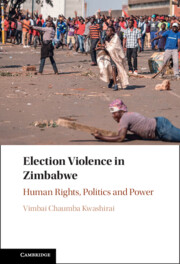Book contents
- Election Violence in Zimbabwe
- Election Violence in Zimbabwe
- Copyright page
- Dedication
- Contents
- Figures
- Tables
- Preface
- Acknowledgements
- Abbreviations
- Introduction
- 1 Violence, a Colonial Curse
- 2 Zanu PF and PF Zapu Violence
- 3 The New Enemy in the 1990 General Elections Was Zum
- 4 Zanu PF on Zanu PF Violence in 1995
- 5 What Presidential Election in 1996?
- 6 The Movement for Democratic Change Was Number One Enemy in 2000
- 7 Presidential Election in 2002
- 8 What General Elections in 2005?
- 9 Disharmony in the 2008 Harmonised Elections
- 10 Violence in the 2013 Elections
- Conclusions
- Recommendations
- Select References
- Index
8 - What General Elections in 2005?
Published online by Cambridge University Press: 23 February 2023
- Election Violence in Zimbabwe
- Election Violence in Zimbabwe
- Copyright page
- Dedication
- Contents
- Figures
- Tables
- Preface
- Acknowledgements
- Abbreviations
- Introduction
- 1 Violence, a Colonial Curse
- 2 Zanu PF and PF Zapu Violence
- 3 The New Enemy in the 1990 General Elections Was Zum
- 4 Zanu PF on Zanu PF Violence in 1995
- 5 What Presidential Election in 1996?
- 6 The Movement for Democratic Change Was Number One Enemy in 2000
- 7 Presidential Election in 2002
- 8 What General Elections in 2005?
- 9 Disharmony in the 2008 Harmonised Elections
- 10 Violence in the 2013 Elections
- Conclusions
- Recommendations
- Select References
- Index
Summary
In 2005, voters in Zimbabwe performed their civic duty in the seventh election since 1980. The preceding three years were crucial to understanding the 2005 election. Many sources of violence existed in this intervening time, influenced by the referendum vendetta, the continuing land reform process, and the apparent bitterness engendered by the 2000 and 2002 election outcomes. It was crystal clear that Zanu PF’s first weapon of choice in elections was stick rather than carrot. Zanu PF viewed MDC voters as minors and Western stooges and its own supporters as adults of unquestionable loyalty and obedience. State patronage and state-sponsored violence had always taken centre stage before, during and after elections. The violent May 2005 Operation Murambatsvina was a largely state-sponsored campaign (with support from some businesses) to stifle dissent and independent economic and political activity in the country’s urban areas. The main victims of Murambatsvina were younger and unemployed, whom state security agents saw as potential recruits for social unrest. The extent of Zimbabwe’s poor human rights record was exposed by new information technology and increased reporting. As Zimbabwe prepared for the 31 March 2005 parliamentary election, Zanu PF’s campaign was decidedly violent and anti-Western.
Keywords
- Type
- Chapter
- Information
- Election Violence in ZimbabweHuman Rights, Politics and Power, pp. 184 - 215Publisher: Cambridge University PressPrint publication year: 2023

